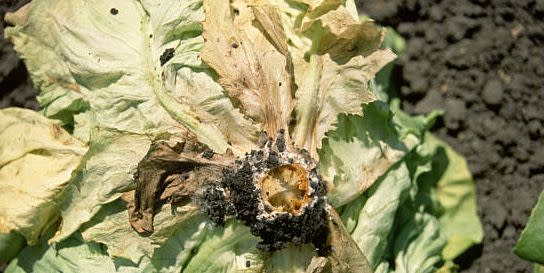How to Treat White Mold, the Sneaky Disease That's Probably Killing Your Plants

Got mold? By the time you notice your plants are wilting, it may already be too late! White mold, called Sclerotinia sclerotiorum, is a common fungus that infects more than 350 species of plants. It’s often found on edibles such as beans, peppers, and lettuce. But it also attacks perennials such as chrysanthemums and hardy winter annuals such as snapdragon. Keep an eye out: If you notice a fuzzy white substance on wilted ornamentals in spring or fall, you may be dealing with white mold.
There's a good chance, unfortunately, that you will come across it. According to a recent survey of 800 gardeners by Gardens Alive, "white mold" was "by far, the most-searched plant disease" across the country. Other names you’ll hear for this disease include stem rot, stem canker, and damping off.
Here’s what you should know about this common plant disease:
How does white mold infect plants?
At the beginning of the growing season, when the soil heats up to between 50 and 80 degrees, the fungus produces spores. They shoot out into the air when the humidity drops and are blown long distances, infecting other plants. Incredibly, the fungus can survive for years in the soil as sclerotia, which are hard irregularly-shaped black masses that develop within and on the surfaces of diseased plant parts.
How can I tell if my plant is infected with white mold?
Symptoms vary depending on the plant affected. You may see stem lesions, wilting stems, or brown spots on flower petals and buds. Cottony masses may appear on stems or on nearby soil. You also may find sclerotia on plants or even inside plant stems. Not sure if what you're looking at is white mold? Consult your local university coop extension service (find yours here) for help with identification.
How can I treat white mold?
Unfortunately, it’s very difficult to treat white mold once it’s taken hold. Oftentimes, gardeners don’t notice anything until a plant dies! But you can give it a shot if you catch it early. First, remove the infected and wilting plants so that more sclerotia are not dropped into the garden to infect other plants. Don’t compost the diseased plants; instead, dispose of them.
Typically, fungicides work best to prevent, not treat, disease. However, you can try treat a plant infected with white mold using a fungicide containing thiophanate-methyl. Follow the label directions; you’ll need regular applications for control.
Can I prevent white mold?
Looking forward, try to present a less inviting environment for fungi to take hold. Spacing plants out for better air circulation or installing raised beds can help prevent outbreaks because the soil dries out more quickly after irrigation. It's also a good idea to rotate crops because the fungi are crop-specific, so a different type of plant may be more resistant to the disease (consult your local coop for advice). In beds where you've had a severe infestation, your only choice is to remove and replace the infected soil with fresh.
Follow House Beautiful on Instagram.
You Might Also Like

 Yahoo News
Yahoo News 